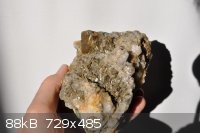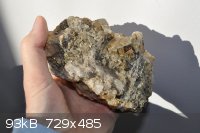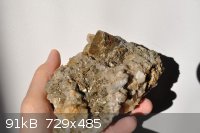Oxydro
Hazard to Others
  
Posts: 152
Registered: 24-5-2004
Location: NS, Canada
Member Is Offline
Mood: distracted
|
|
Ozone oxidation of pyrite ore
A friend of mine is a small-scale gold prospector/miner. Mainly just sluicing / panning, he is actually also attempting to remediate an old (century+)
gold mine, but that's besides the point.
He collects a fair amount of pyrite/arsenopyrite ore, which is difficult to extract the small amount of gold from. Industrially I suppose they would
use cyanide - he isn't into that for safety and environmental reasons.
As these pyrites are sulfides, I am under the impression that ozone will oxidize them to the respective sulphates. Since I was already planning on
making an ozone generator, I thought I should attempt this. I'm looking for any insight anyone has on the process, reaction conditions and the like.
One thing I take seriously is the arsenic contained in the ore - I don't want to poison myself, and I also don't want to create an environmental
hazard, so I'd appreciate any thoughts in that respect.
The only useful paper I've found so far deals with ozone treatment on ores to be processed with cyanide, it is talking about a) a different extraction
process and b) lower grade ore:
http://biblioteca.cinvestav.mx/indicadores/texto_completo/ci...
I'll post more details of my intended process later (when I'm not at work, and when I have a little more idea what I'm doing).
Edit: The arsenic should form the trioxide. Not the sulphate as I implied above.
[Edited on 15-3-13 by Oxydro]
"Our interest's on the dangerous side of things" -- Browning
|
|
|
Morgan
International Hazard
    
Posts: 1660
Registered: 28-12-2010
Member Is Offline
Mood: No Mood
|
|
I was surprised to see how much arsenic is in this type of pyrite.
"With 46% arsenic content, arsenopyrite, along with orpiment, is a principal ore of arsenic."
http://en.wikipedia.org/wiki/Arsenopyrite
"Carlin–type gold deposits are sediment-hosted disseminated gold deposits. These deposits are characterized by invisible (typically microscopic
and/or dissolved) gold in pyrite and arsenopyrite."
"The Carlin type deposits show enrichment in the elements gold, antimony, mercury, thallium and barium."
http://en.wikipedia.org/wiki/Carlin%E2%80%93type_gold_deposi...
I thought pyrite was kind of uninteresting but there are some curious qualities about it.
http://www.youtube.com/watch?v=InZ0Dg9dKO8#t=1m14s
"A helical spring mechanism is shown in his Codex Atlanticus (c.1500) manuscript and several dated wheel lock rifles and pistols based on this
principle are known from the 1530s. The spring-driven serrated wheel, when brought into contact with a piece of iron pyrite or flint in the jaws of
the hammer, produced sparks to ignite the priming in an exterior pan."
http://www.youtube.com/watch?v=6Qb5PkRaxkk
http://en.wikipedia.org/wiki/Pyrite
I wonder what trace elements are in this ordinary piece of pyrite I have?
  
|
|
|
AJKOER
Radically Dubious
    
Posts: 3026
Registered: 7-5-2011
Member Is Offline
Mood: No Mood
|
|
How about this less toxic and expensive route (see https://docs.google.com/viewer?a=v&q=cache:fSX7NywebY0J:... ). To quote:
"ADVANTAGES
Like cyanide, thiosulphate leaching is
an alkaline process (usually operated in
the pH 8 to 10 range) so there are no
concerns with corrosion and materials
used in construction, and the process
can be applied to heaps and dumps, or to
stirred tanks. The thiosulphate process
offers advantages over cyanide leaching
in the following situations:
• Thiosulphate leaching yields
similar gold recovery as cyanide in
some cases, while in cases such
as preg-robbing ores (naturally
occurring carbonaceous material
that preferentially absorbs the gold
cyanide complex but not the gold
thiosulphate complex), it can yield
substantially better recovery than
cyanide.
The thiosulphate leaching of gold
ores has great potential to reduce the
impact on the environment compared
to the cyanidation process. Unlike
cyanide, which is highly toxic, the
chemicals used in the thiosulphate
leaching process are benign, and
there is great potential to apply the
technology in those jurisdictions of
the world where the use of cyanide
is banned outright, or is subject
to intense negative publicity for
environmental reasons. The main
chemical components of the leaching
process (ammonium thiosulphate
and ammonium sulphate) are
common fertilizers, which opens
up the additional possibility of using
mine tailings solutions in agricultural
applications, in regions of the world
where the local infrastructure and
environmental regulations are
favourable.
• TECHNICAL LIMITATIONS
The chemistry involved in the thiosulphate
leaching process is more complex and
less robust than the cyanide leaching
process, and is therefore more difficult to
optimize and more sensitive to operate.
The leach process involves a chemical
reaction between metallic gold and the
thiosulphate anion, with oxygen as the
oxidant, and ammonium and copper ions
as unconsumed catalysts in the reaction.
One possible scheme for the overall
reaction is presented below:
4Au + 8S2O3 + O2 + 2H2O → 4Au
3–
(S2O3 ) 2 + 4OH -
While it is relatively easy, in just a few
tests, to establish the amenability of an
ore to cyanide leaching and optimize
the process, the thiosulphate chemistry
presents technical challenges and
requires careful optimization. Thiosulphate
leaching is a sensitive process that
requires both dependent and independent
optimization of each of the chemical
components of the leach reaction, as
well as physical parameters such as
pulp density and temperature, in order
to maximize gold recovery and minimize
reagent losses.
The sensitivity of the thiosulphate
leaching reaction stems from the fact that
the reaction thermodynamics are less
favorable than the cyanide leach reaction.
Consequently, higher concentrations
of thiosulphate are needed to achieve
equivalent rates of gold leaching, and a
typical thiosulphate leach solution will
have a reagent concentration of 5 to 20
g/L versus a cyanide concentration of only
0.25 to 1 g/L. The higher concentration
of thiosulphate required leads to higher
reagent consumption, which is at least
partially offset by the significantly lower
cost of thiosulphate, which could be as
little as one fifth the cost of cyanide. It
will generally still be important either to
recycle the thiosulphate tailings solution
back to the leach plant to minimize
thiosulphate losses and new thiosulphate
make up requirements, or use the tailings
solution productively as a fertilizer.
The gold thiosulphate complex is very
poorly adsorbed by activated carbon,
negating the use of the traditional
carbon-in- pulp (CIP) or carbon-in-leach
(CIL) processes for the recovery of gold
directly from leach pulps...."
OK, on a small scale, the associated "greater complexity", you may be able to overcome. I am still, however, skeptical on any possible economic
profit. More work on the precise process, average yield and marginal cost.
[Edited on 15-3-2013 by AJKOER]
|
|
|
|